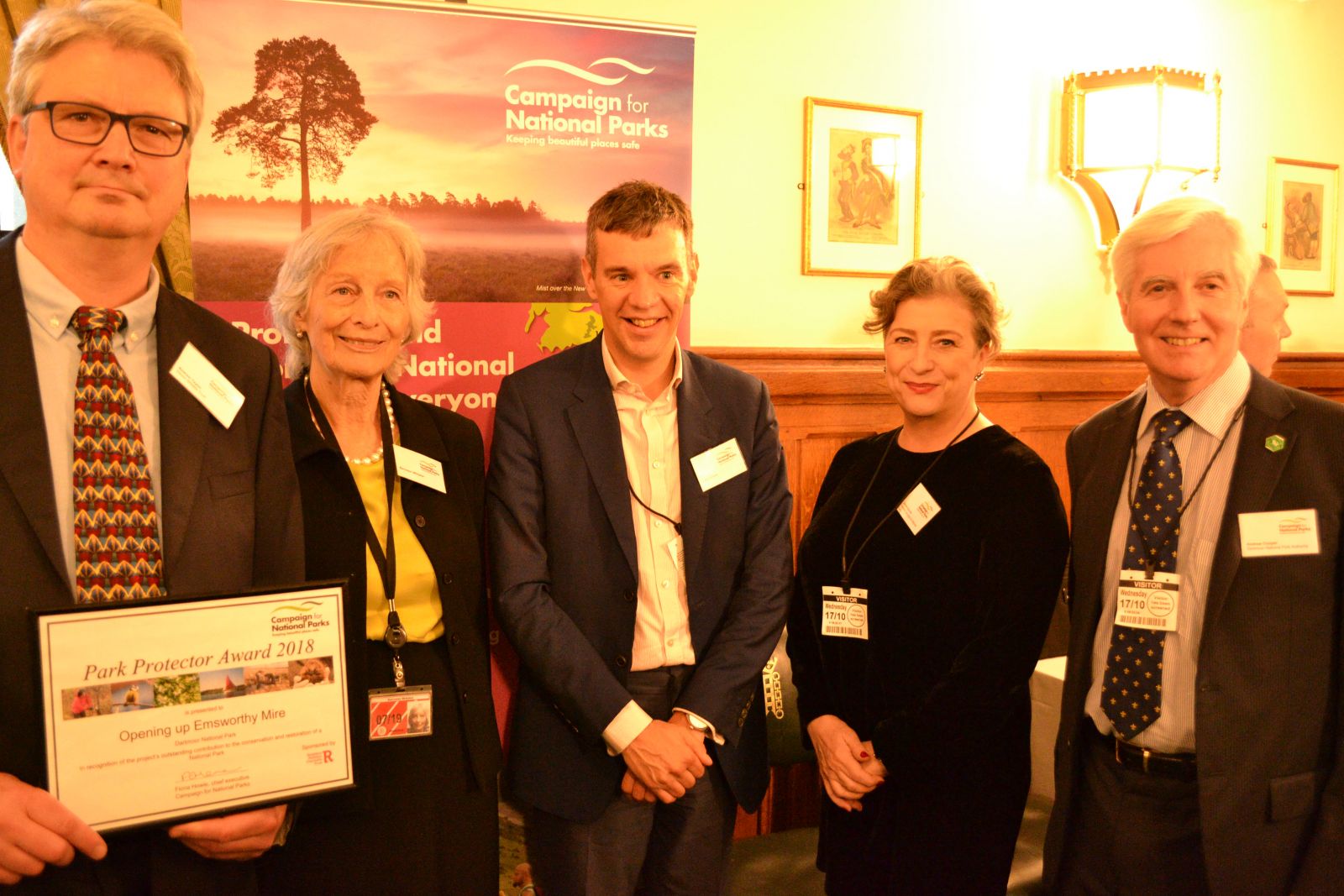Opening up Emsworthy Mire
15 April 2019
Andrew Taylor of the Devon Wildlife Trust talks about the Dartmoor project and winner of the 2018 Park Protector Award.
Emsworthy Mire on Dartmoor became a Devon Wildlife Trust nature reserve in 2012. The mire itself is a magical place full of cotton grass and flowering bog bean, famed for its cuckoos and rare marsh fritillary butterflies. It’s surrounded by a mosaic of bluebell fields, gnarly woodlands, rough pastures, streams and ponds. The reserve occupies the valleys of the Becka and Snodderbottom Brooks, and its rocky upper slopes offer amazing panoramas of a dozen of Dartmoor’s majestic granite tors.

Emsworthy Mire is a spectacular Dartmoor nature reserve. Photo credit: Andrew Taylor
I was captivated by this spectacular 99 hectare “Dartmoor in Miniature” from the moment I saw it. Having inveigled my way into the post of Volunteer Nature Reserve Warden, I had most of the site to myself for four years. Two thirds of Emsworthy was impenetrable unless you were armed with compass and machete. I emerged from its depths in in 2016 with mud up to my eyebrows, a map of possible access routes, and suggestions for habitat enhancements. Then the hard work began.
Fast forward: it’s autumn 2018. In a bizarre turn of events, the Volunteer Warden has swapped wellington boots and band-aids for a suit, a tie and a date with Caroline Quentin at The Houses of Parliament. Caroline is here to present the Campaign for National Parks’ “Park Protector Award” and a splendid £2,000 cheque from Ramblers Holidays Charitable Trust. I’m here to receive them on behalf of Devon Wildlife Trust’s nature reserves team.

Opening up Emsworthy Mire winning the 2018 Park Protector Award. With the award presented by Baroness Whitaker, Julian Glover and Campaign for National Park’s president, Caroline Quentin.
“Opening Up Emsworthy Mire” won the Campaign’s 2018 Award thanks to DWT’s amazing South Devon and Dartmoor volunteers, a group of tireless, multi-skilled enthusiasts who have spent dozens of days hacking hiking routes through bracken, willow and gorse, building boardwalks across brooks and bogs, and setting up signs and markers to guide visitors around 5km of new trails.
Exploring Emsworthy is now an adventure that thousands of people a year can enjoy. With more visitors, we’re learning more about the exciting wildlife we have here. Discoveries include Parmelia submontana, a luxuriant lichen previously unknown in England; bog hoverflies, creatures so scarce that they were believed to be extinct until their rediscovery on Dartmoor; and one of Devon’s largest breeding populations of snipe.

Boardwalks have opening up the site so visitors can enjoy this rich landscape. Photo credit: Andrew Taylor
Fast forward again: I’m writing this on the 4th of April. Chiffchaffs are back from southern Europe, taking up territories all around the reserve, and snipe are chipping away in the mire. Spring hasn’t quite sprung but anticipation’s building. A redstart was seen today just down the valley, fresh in from Africa. This is one of our reserve’s special species, and our first breeding male should be singing in the huge sycamores above the ruined Emsworthy farmstead any day now. Meanwhile the first of the BTO’s radio-tracked cuckoos has just crossed the Sahara, so our own birds should be well on their way too. In May we often hear two or three competing males cuckoo-ing across the mire at once, while the females they’re fighting for are on the beady-eyed lookout for pipit nests to parasitise.

An emsworthy redstart. Photo credit: Robin Morrison.
Many smaller creatures are already here, but in hiding. Marsh fritillary caterpillars are lurking in silk tents in the mire tussocks. Keeled skimmer dragonflies are in their aquatic nymph stage, roaming the mire’s runnels. They’re nationally scarce, but so numerous here that by June we’ll be watching every footfall to avoid squishing emerging adults. Over in the ponds are some of our most surprising residents, the brown china mark moths. As caterpillars they cut bits of greenery to make tents, and glue them to the undersides of pondweed leaves; they then spend their larval lives feeding underwater. In early summer they’ll pupate at the water’s edge, then emerge to fly in spectacular numbers and lay the next generation of eggs into the pond.
Wild flowers? Try Googling “Emsworthy bluebells” for a flavour of this celebrated seasonal spectacle. Bear in mind that our high-altitude, open-field display is much later than those in lowland woods; they’re unlikely to bloom until mid May.

stunning emsworthy bluebells. Photo credit: Andrew Taylor.
These are just some of the highlights I’m looking forward to at Emsworthy Mire over the next few months. You can click here to see more in a ten-minute film which was shot last June. Better still…visit the reserve yourself this spring.
By Andrew Taylor,
Devon Wildlife Trust.
The Park Protector Awards are sponsored by the Ramblers Holidays Charitable Trust.
